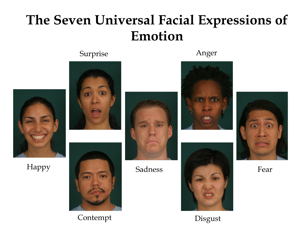In the previous blog (So You Want to Be An Expert part 1) we talked a bit more about why study the face, we reviewed macro-, micro- and subtle expression and we covered Step 1: Learning What to Look For. The take home point for Step 1: since the face conveys lots of information, you want to learn what to look for given your specific interest or profession and what you should ignore. We call it creating a baseline.
Step 2: Recognizing What You Are Seeing
If you are interested in detecting facial expressions of emotion, which of course we are, the next step is to learn which expressions are associated with which emotion. Here’s an example:

It is simple enough to identify these “macro” expressions of emotion in still photographs by just looking at them. But people tend not to walk around with their faces frozen in an expression. Macroexpressions, like the ones in these images – last between ½ to 4 seconds. This is what people show on their face when they are not trying to conceal or repress what they are feeling. But what if they are? We can see microexpressions because of something scientists call “leakage”. This leakage is the facial expression equivalent of “oops, my bad!” When a person is thinking one thing (cognition) and feeling another, there is a little tug-of-war going on inside the brain. The quick flash of a microexpression – which shows what the person is really feeling in that instant – literally leaks out as a result of this internal struggle. Microexpressions last ½ second or less – they move on and off the face incredibly quickly and have been clocked at speeds as fast as 1/15 of a second. That’s fast. But if you know what to look for (Step 1) and you understand what you are seeing when it happens (Step 2) you can learn to identify microexpressions of emotion.
In order to teach others how to do this in a way that makes the science useful and applicable to every day life, scientists first had to figure out what was going on by using an objective (scientifically based) system to study the muscle movements associated with facial expression of emotion. Here was the challenge: could you reliably and predictably correlate certain muscle movements with certain emotions? Turns out that the answer was “yes”.
This system had to be based on identifying and measuring defined facial expressions of emotion. Hjortsjo developed the first system of this type in 1969. He “described the changes in facial appearance resulting from the action of each facial muscle”. Paul Ekman and W.V. Friesen followed Hjortsjo’s method, using his results to confirm their own and created the Facial Action Coding System (FACS) we use today. Since not all of the possible muscle movements actually produced changes in facial appearance, Ekman and Friesen focused on what they called “action units” or AUs. There are about 44 AUs and each of them is associated with an individually producible facial movement. AUs can be scored on a five-point intensity scale. Most recently, we have updated the dictionary and AUs used to code many different variants of the emotions, as well as signs of cognition, pain and some emblematic facial gestures in our system called HUMINFACS.
Remember that I mentioned that there was a caveat to learning what to look for, and that this caveat was that it is natural for us to apply our own cultural bias and judgments to what we are seeing? One way to compensate for this is to use an objective (scientifically based) system, like FACS – to code facial behavior. This means that I can overcome my innate biases – whatever they may be – and learn to reliably read faces.
Step 2 Take Home Point
If you want to learn to read faces, you need to learn to reliably recognize facial expressions. Start with the seven universal expressions of emotion (joy, sadness, fear, surprise, anger, contempt and disgust). Chances are you already know what the macro- version of these expressions look like. Some people do have issues recognizing macroexpressions. If you need some help learning or practicing macroexpressions, you can use our Macroexpression Recognition Training (Humintell MAX) to help you learn. So the next step is to learn how to spot the microexpressions of these emotions.
How to Learn Microexpressions
If you want to learn microexpressions, try our self-paced, interactive online Microexpression Recognition Training (Humintell MIX) . This training has been scientifically proven to improve a person’s ability to detect microexpressions. You will learn the same powerful observation tools – based on the Matsumoto Method – that U.S. Government agencies and Fortune 500 companies use everyday. Scientifically proven, field-tested. It works.
Next Steps
Don’t miss the next blog! In the last part of “So You Want to be an Expert” (Part 3) we’ll talk about how to put it all together.
Rather interesting. Has few times re-read for this purpose to remember. Thanks for interesting article. Waiting for trackback
For years i’ve been interested in Micro and Macro expressions. I’ve watched every episode of “Lie to me”, and most likely will watch every re-run. I find this article very insightful. However; I am unable to find your previous article, Part 1. Could you redirect me?
Hi Garth, it can be found here. Thanks! http://www.humintell.com/2009/07/so-you-want-to-be-an-expert-1/